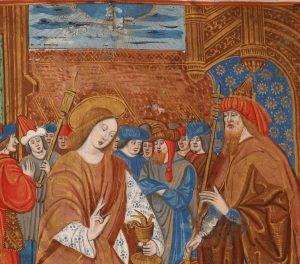This blog post comes from one of our four Freshman Fellows, Sarah Elbasheer, who is researching the ways people valued books at and after the time of print, and how we treat those books today. [Click here to learn more about our Freshman Fellows program]
The first time I stumbled across JHU’s “Cathedral of Books,” otherwise known as the George Peabody Library, I was Googling “most beautiful libraries in the US.” When I saw it amidst the top results, I was in awe of the sheer size of the collection and the beautiful way the books were housed. Years later it turns out that I would come to attend Hopkins, and the library was one of the reasons that I was so excited. I could definitely see myself working there as a university student, donning a woolen cloak and penning a sophisticated dissertation, a stack of fine-looking old tomes and manuscripts at my side. Imagine my excitement when another Google search led me to the Special Collections Freshman Fellows Program, “A Year-Long Experience in Research & Mentoring.” I read that the program facilitated humanities research with rare primary-source material for first-year students like myself. Of course, I eagerly took the opportunity to apply, and happened to find a proposed topic on those very same tomes: looking into the ways that people value books as objects as well as texts.

One of the first books I handled in my research was the Ship of Fools, an aptly named medieval satire filled with illustrations of people its fifteenth-century author, Sebastian Brant, deemed “fools.” One of the first people it describes (in the image shown left) is of the “Book Fool,” a person who dresses smartly and collects old manuscripts for their fancy library, constantly dusting and caring for them, yet never understanding what is held within their pages. I have always held a fascination with the physical book, in the tangibility of reading it and the pleasure of owning it. As I found later in my research, people throughout history have shared this attachment. I found that the way we’ve always cherished the book is most interestingly clear when there is a threat posed to their existence by some kind of technological advancement. For example, ten years ago I considered myself among the E-book’s greatest critics and a self-proclaimed advocate of the printed book. As I began my project, I discovered that about 500 years ago a German abbot named Johannes Trithemius wrote “In Praise of Scribes,” an entire book dedicated to criticizing the printed book and glorifying the handwritten book. Both of us shared similar reactions to new developments in the making of our books, because despite the similarity in the information on the pages, we valued them based on the way they appeared to us as objects. In my research, I plan to explore this value. Are traditional forms of books valuable as relics for us to admire? Are libraries just museums for us to tour? Are we all just “Book Fools?”

Looking through our own library’s collection in search of such answers has been absolutely amazing. In a mind-boggling way, the process of researching itself is my research: by looking for knowledge from within the books Special Collections itself has preserved over the years, I can look more deeply into the reason for our keeping them in the first place, and try to figure out what makes books so special. As an aspiring scientist, artist, and historian, I’m interested in using my discoveries to understand how the ways we’ve externalized knowledge have changed. By looking at books produced during the medieval period and their advancements during the Renaissance and the Scientific Revolution, I want to explore how our knowledge of the past combines with our apprehension of change in the future.
